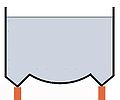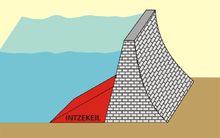Intze principle
Two different construction principles are called the Intze principle . Both go to the water engineering - engineering Intze Otto back (1843-1904). One Intze principle relates to the construction of a water tower, the other to the construction of a dam.
Intze principle in water towers
A water tower built according to the Intze principle has a water tank, the bottom of which is initially drawn in at an angle and then rests in a ring shape on the shaft of the tower. In contrast, the inner area of the bottom is convex upwards. This enables a slim support structure. No horizontal forces, only vertical forces are introduced into the tower shaft, which can therefore be made less massive. This design was used in Germany between 1885 and 1905 in particular.
- Water tanks designed according to the Intze principle
The Intze-1 container can be built entirely from masonry , as long as the outward forces are absorbed by circumferential belt straps or ring anchors .
Intze-1 container with inner cylinder to accommodate the spiral staircase
Intze principle for dams
The dam construction method according to Otto Intze was used in Germany at the end of the 19th century and beginning of the 20th century. A dam built according to the Intze principle has the following characteristics:
- It is a gravity dam with an almost triangular cross-section.
- The wall consists of quarry stone masonry with a high proportion of mortar.
- It has an arched floor plan.
- It has a facing masonry (facing) on the water side in the upper area.
- It has an embankment made of clay on the water side, the "Intzekeil", in the lower area.
- It has a sealed with concrete water side and on a Naturasphalt- ( tar -) Inertol - or Siderosthen -Anstrich.
- It has vertical drainage from clay pipes behind the water side.
The Intzekeil should also seal the wall in the area of the highest water pressure. Today it is considered to be obsolete in this construction.
See also
Individual evidence
- ↑ zagermann.de
- ↑ Intzekeil
- ↑ Information brochure Ruhrverband
- ↑ Otto Intze and the construction of the dam ( Memento from December 5, 2013 in the Internet Archive )
Web links
- Otto Intze and the water tower
- Otto Intze and the dam construction ( Memento from December 5, 2013 in the Internet Archive )
- Intze container on wassertuerme.gmxhome.de




